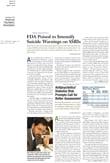I’d like to begin this month’s patient safety article with a correction: The summary of the last article in the series, “A Few Simple Steps Can Avert Medical Errors,” published in the February 6 issue, stated that “[m]ost malpractice lawsuits against psychiatrists stem from medication errors.” The summary should have quoted Charles Cash, J.D., as saying, “Most lawsuits against psychiatrists include allegations involving medications, and many of those lawsuits involve preventable medication events.”
Medical errors in psychiatry came into the national spotlight years ago due to a series of articles in the Hartford Courant investigating patient deaths during seclusion and restraint. Patient safety during this intervention is a serious concern. In fact, seclusion and restraint has been identified by APA’s Task Force on Patient Safety as one of the three priority areas to reduce preventable adverse events in psychiatric practice. The risk management process can be used to manage the risks of harm from seclusion and restraint, not only to the patient, but also to staff.
Step 1: Identify Current and Potential Risks
Risks to the patient associated with seclusion and restraint include emotional and/or psychological harm, physical injury, and even death. The psychiatrist and facility also have risks associated with such adverse events, which could include any combination of the following: litigation against the facility and psychiatrist, licensing board complaints against the psychiatrist, and investigation of the facility by the government and/or accrediting organization. And, although the focus of this article is on patient safety, it should be noted that injuries related to restraint and seclusion of patients are among the most frequent workplace injuries for mental health care workers.
Step 2. Evaluate Risks (Frequency and Severity)
There have been concentrated efforts, in addition to governmental mandates, to decrease the use of seclusion and restraint, and thus the frequency of potential risks. The severity of injury can range from less severe to very high, as evidenced by reported cases of patient deaths.
As mentioned above, the risk to employees is significant; in fact, one of the most costly impacts of use of seclusion and restraint is the workers’ compensation costs related to employee injury. Other adverse impacts on employees could include decreased worker productivity, decreased employee satisfaction and morale, and increased employee turnover. These negative impacts on employees could hamper efforts to create a culture of safety.
Step 3: Choose a Risk Management Strategy
To manage the risks associated with the use of seclusion and restraint, individual psychiatrists need to understand their professional liability exposure and the important role their involvement and leadership can play in improving patient safety and decreasing their liability.
While individual psychiatrists, either in the role of attending physician or medical director (responsible for seclusion and restraint policies and procedures), may not often be involved in an intervention utilizing seclusion and restraint, they are likely to be named in any lawsuit resulting from such intervention. Therefore, in terms of patient safety and professional liability, the only appropriate risk management strategy for a psychiatrist is to ensure patients’ clinical needs are appropriately met. In fact, the APA Task Force on Patient Safety recommends that individual psychiatrists “support programmatic efforts to minimize the use of restraints and seclusion and to ensure that, when such interventions are necessary based on clinical judgment, they are administered safely by trained personnel,” and they should “seek information about best practices.”
The psychiatrist needs to review the facility’s seclusion and restraint policies and procedures; minimizing the risks associated with the use of seclusion and restraint revolves around the development, use, evaluation, and improvement of a system. The use of a systems approach for seclusion and restraint is, in effect, mandated by regulations from the Centers for Medicare and Medicaid Services, formerly the Health Care Financing Administration, and JCAHO accreditation standards.
When evaluating a facility’s system, keep in mind that the optimal system consists of policies and procedures that are understood by all staff, implemented appropriately, and re-assessed with the goal of utilizing seclusion and restraint as infrequently as possible to ensure the safety of the patient and the staff. In developing, reviewing, and improving a facility’s system, the psychiatrist should remember the following:
• Seclusion and restraint should only be used as a last-resort treatment.
• State and federal law must be complied with, and accreditation standards must be met.
• Only accepted techniques are to be used—providers must be knowledgeable about current intervention techniques and professional standards and guidelines, including those addressing special populations such as geriatric, child/adolescent, and hearing-impaired patients.
• Staff must receive orientation, training, and reviews regarding seclusion and restraint practices.
• Adequate education about seclusion and restraint must be provided to patients, families, and significant others.
• Each episode of seclusion or restraint of a patient should be reviewed with staff.
Step 4: Implement the Strategy
Everyone involved in patient care needs to be committed to making the system work, and the importance of the psychiatrist’s support of a clinical culture of safety cannot be understated. A facility can have the best seclusion and restraint policies and procedures on paper, but if they are not followed, patient care may suffer. Psychiatrists need to be vigilant and advocate for continued reduction in the use of seclusion and restraint. Meeting the patients’ clinical needs will reduce the psychiatrist’s liability exposure, whether the involvement is as an attending psychiatrist or a psychiatrist in an administrative role, such as medical director.
Step 5: Evaluate the Strategy
This final step in the risk management process is a continuous one. Each use of seclusion and restraint must be assessed, and psychiatrists should continue to advocate for additional therapeutic interventions to limit further the use of seclusion and restraint. Successful efforts should continue to be shared with colleagues.
Using the risk management process to approach the issue of seclusion and restraint supports the quality of care provided to patients, which corresponds to increased patient safety as well as patient satisfaction. ▪
